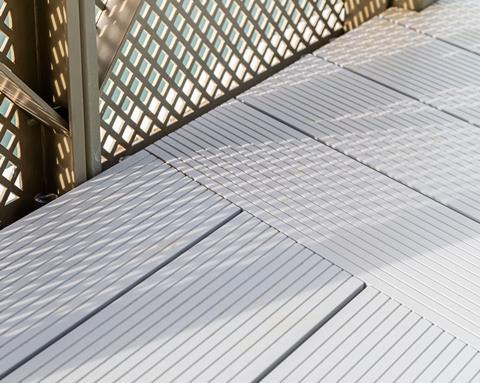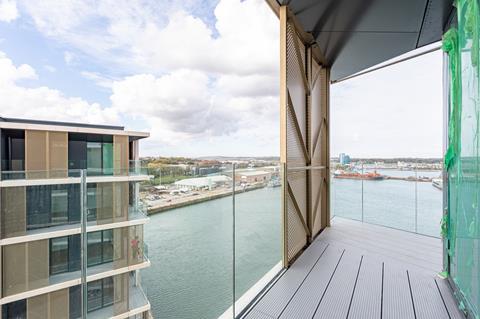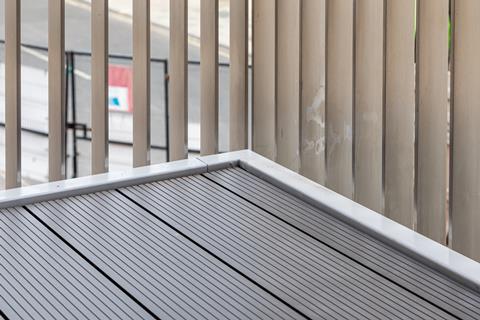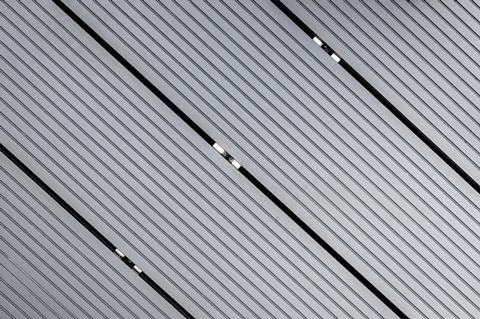As a relatively new material in decking design, many specifiers still question aluminium’s suitability. RYNO answers some frequently asked questions regarding compliance, installation and heat transference

Aluminium is quickly becoming the construction industry’s go-to material for balcony and terrace decking systems. As well as benefiting from a fantastic finish and a contemporary look and feel, it is non-combustible, slip-resistant, durable, corrosion-protected and low-maintenance. For these reasons, construction specialists are opting for aluminium decking in a growing number of new build and remediation projects.
However, as aluminium is a relatively new material in decking design, many people still question its suitability. In this article, we answer some of the most frequently asked questions regarding aluminium decking and cover the key considerations when choosing a decking material.

Is aluminium decking compliant with safety regulations?
One of aluminium’s most significant benefits is its non-combustibility. It can be heated to extremely high temperatures without producing flames or smoke. This ensures it is a fantastic choice of decking material for architects and construction professionals who want to guarantee compliance with safety standards.
It is particularly relevant to buildings that fall under the purview of the post-Grenfell fire regulations that banned combustible materials on the exterior walls of constructions exceeding 18 metres in height.
These qualities have also ensured that aluminium is regularly used in remediation projects to replace combustible materials in high-rise buildings. It is often incorporated into decking systems specifically designed to replace outdated composite and timber boards.
If you are seeking additional information on aluminium decking in a remediation context, we recommend contacting an industry specialist to discuss your needs.
How is aluminium decking installed?
Aluminium decking can be installed in several ways depending on the balcony and terrace design. On balconies, aluminium decking systems are incorporated into steel, bolt-on and cantilever balconies by fixing them directly to the balcony steel. Joist hangers provide additional support in existing balconies, while decking cleats are incorporated into the system to raise the decking and provide additional height. Advanced systems also benefit from clip-in boards for easy installation.
On terraces, height-adjustable joist pedestals are often utilised to raise the decking off the substrate and facilitate a simple installation. Cleats can also be used to provide low-height support, while spreader plates distribute joist pressure more evenly across the substrate if required.

How much does aluminium decking cost?
As with most construction projects, the cost of aluminium decking varies significantly depending on the build’s size, scope and complexity. Material trading prices, material quality, whether the decking is for a terrace or balcony, and how those systems are engineered all dictate the overall cost.
Some of these factors are relatively stable. For instance, aluminium prices are not prone to significant fluctuations. Others have a big impact. A terrace typically costs more than a balcony because the decking needs to be raised above the underlying substrate.
Similarly, upper-floor balconies on high-rise buildings will be more costly than those on the first or second floor because of the infrastructure required to install them.
One thing to always remember is that you can always reduce costs by planning your decking at the balcony or terrace design stage.
Designing a balcony without considering the decking makes it challenging to optimise for cost efficiency. You typically end up with unnecessary joints and wastage. With forward-thinking, you can design the balcony or terrace with the decking system in mind and minimise costs.

Does aluminium decking get hot?
People are often concerned that aluminium decking will get too hot in the summer and become unusable. In reality, this does not happen. Compared to other common decking materials, such as wood, aluminium has a high specific heat capacity. This means it takes less energy to heat the material. However, it also means heat dissipates, and the material cools more quickly.
At the same time, aluminium is also a more efficient thermal conductor than other materials, so the heat is distributed across it more easily. As a result, it cools quickly.
These two factors, coupled with design features like a ridged “heat sink” surface, make aluminium an excellent decking material. It may require less energy to heat up than wood, but that heat is distributed more evenly across the surface, exposing it to more cooling airflow and allowing it to dissipate.
The colour of the finish will also affect temperature. Lighter colours reflect more heat, while darker hues absorb more. Naturally, the latter will heat up more than the former. Similarly, aluminium decking on sunny, south-facing balconies will get warmer than those on the north side of a building.
What maintenance does aluminium decking require?
Aluminium decking requires very little maintenance compared to other decking materials. Unlike wood decking, it does not require periodic staining, painting or sealing and is not prone to the same decay as other natural materials.
Aluminium does not absorb water and can be kept rust-free by washing it with warm, soapy water and a non-abrasive cloth or brush. For those who value low-maintenance materials, it outperforms most alternatives and is a sensible, cost-effective option.

Does aluminium decking scratch easily?
Aluminium decking is relatively scratch-resistant. Like any material, you can scratch it if you try hard enough. However, for everyday use, it is a durable and robust choice of material. Durability is further enhanced by the powder coating applied to the surface. This makes it a popular choice amongst construction specialists who value hard-wearing and low-maintenance designs.
RYNO®’s advanced aluminium decking systems
When it comes to aluminium decking, RYNO is an industry leader. Its innovative TerraSmart™ and BalcaSmart™ Aluminium terrace and balcony decking systems are extremely versatile, maximise the material’s core strengths, are designed for easy installation and world-class performance, and are part of the IGNO® Non-Combustible Innovation range which, if installed as a complete system features a 30-year warranty and a 60-year design life.
But it is not just the product that matters. The RYNO team also boasts considerable experience and expertise, as well as an in-depth understanding of the challenges involved in construction and remediation projects.
To learn more about compliant, non-combustible aluminium decking systems, visit the RYNO website today.















